Digital Art History
The 1970's.

A GAIV banner.
From explorers to pioneers.
The digital context. Index of digital artists who started to produce during the 1970's.
Computers become more common, but still affordable only to a happy few. At the end of the decade, the first micro-computers and Internet roots show the ways which the 1980's will begin to follow more massively.
Until this decade, there were mainly two ways for artistic creation: analog (mainly electronic, for instance in music or video) and vectorial. Now we begin to see the progression of digitization at the "document" level: digitally sampled sounds, pixelated images. It's not always easy to see how each author works, how each work is realized.
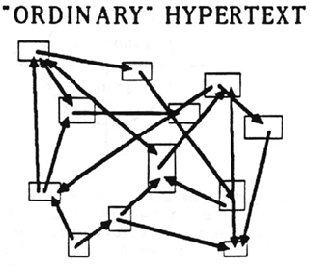
Nelson's hypertext: the basic schema.
Few artists beginning in this period are still famed in the 2010's. Frank Malina for lights, Ted Nelson for hypertext are more explorers of technology than artists properly, Harold Cohen, an abstract painter captivated by generative computing,
The 1960's spirit is still an inspiration, for the GAIV for instance. And artists having started in the 1960's are still in full production (The Beatles, Chris Marker, Manfred Mohr or Vera Molnar).
Events
1970. In the catalog of Tendencije 4. "Many disciples of the Nove Tendencije movement tried to use friendly the machine for their work, or based their methodology upon the use of mechanical, or electrical devices. All of them were dreaming of machines... and now the machines are here". (our translation).
Comments Darko Fritz in [Lartigaud]: "The computer was seen as a tool, granting the "objectivity", the rationality and the legibility of the production process. During the creation of images, it allows a superior precision and the handling or more complex processes. Although the link between concrete art and digital art was clearly stated by the curators of Tendencije 4, among more than 120 participants of the first NT wave, five only jumped the bar, from the first form of art to the second one : Marc Adrian, Waldemar Cordeiro, Iva Picelij, Zdenek Sykora and Herman de Vries".
1970. The principle of "programming" as the central topic of a show triumphs in 1970, when Jack Burnham organizes Sofware Information Technology: Its New Meaning for Art, at the Jewish Museum of New York".
1971. Electronic Arts Intermix (EAI), an advocate and resource for video art, is founded in New York.
1971. The Kitchen is founded in New York by Woody and Steina Vasulka as a collective for video artists, experimental composers, and performers, to share the ideas with like-minded colleagues. (Indicated by [Debatty])
1971 Creation of the GAIV (Groupe art et informatique de Vincennes à Saint-Denis).
1974. The first Siggraph
1977. Satellite Arts Projects. by Kit Galloway, Sherrie Rabinowitz and collaborators.
1979. Ars Electronica is founded
But "Computer art lost gradually its attractivity on the artistic stage during the 1970's... taking to, in the middle of these years, a rejection ot this type of art, and its nearly total exclusion form the contemporary art scene" (Darko Fritz in [Lartigaud], our translation).
Publications and concepts
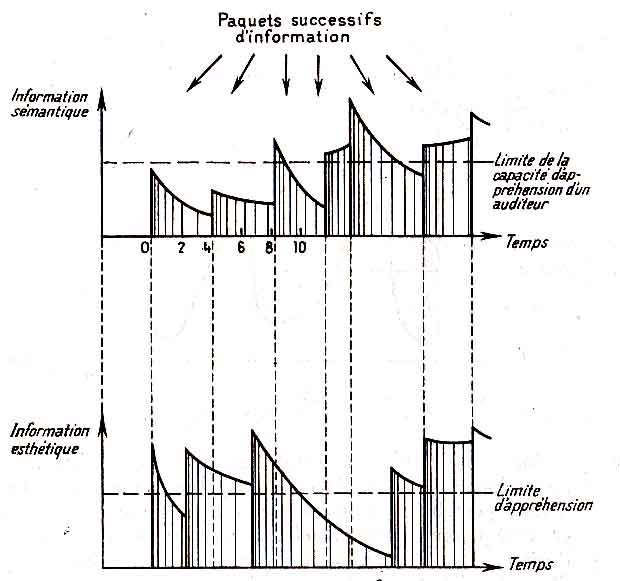
Abraham Moles: the Shannonian view of Aesthetics (1972).
1975. The word fractal is coined by Benoit Mandelbrot.
1976. Ruth Leavitt publishes Artist and computer.
1972. Abraham Moles publishes Théorie de l'information et perception esthétique.
1975. Popper publishes Act, action et participation. in which he develops the idea of a democratic art to come if not yet present... "... I was dealing with art use in new immaterial materials, such as light and movement, leading to the mutation of the art object into a proposal on the architectural and environmental scale. From this fact, I was seeing the artist more as a programmer, enhancing the engagement of the spectator in different domains such as plastic marts, music, dance, theater, television". [Popper 1] p. 35
1978. In France, the Nora-Minc report creates the word "telematics", which will cause notably the launching of minitel in 1982. President Giscard d'Estaing engages himself in person : "The systematic and rapid exploration of musical, plastic, literary or poetic forms may help the creator and stir the creation. The computers influence of the computer upon contemporary music is already perceptible. The methods of "computer aided design", applied to drawing, painting, sculpture, contains a promise of renewed forms. Even literature may be stimulated by a systematic and guided exploration of "formal possible"".
About Japan during theses decades, see 1910-1970. Japon des avant-gardes. Centre Pompidou, Paris, 1986.
(Now set out of access) A collection of works relating the take off of computer art, was presented on the Cache project(UK), is indicated by Darko Fritz in [Lartigaud]
See the website of Chrisph Kluetsch
Writing
In spite of the comparative easiness of text processing (compared to images and a fortiori to film), few artists play this game. The main artist here is Angel-Luis Arambilet-Alvarez. He publishes Artes y Letras (1978), considered in the Latino-America world the first short story written by computer, and Arte y Cibernetica (1978) the first graphical poem (combines text and graphics).Philip Bootz publishes some poems, but is mainly known for his wide synthesis about digital literature, published in 2006 by Leonardo-Olats.
Jean-Jacques Lebel is a writer, but mainly a creator of happenings and films. Ted Nelson is not an artist, but he created the important term hypertext and published several books.
Music

Jean-Claude Risset. Music from science.
As generally in music, we have a divide (not absolute) between savant and popular music. In both cases, we should check how far goes the digital sampling.
On the savant side, note the Unesco symposium Music, science and technology, the composer in the technologic era (1970, Revue Musicale, Paris 1971c.) and in
1977 the creation of Ircam (Institut de recherche et de coordination acoustique/musique) in Paris.
Artists on this side:
John Chowning discovers in 1967 the principle of synthesis by frequence modulation, with an algorithm where the carrier and the modulated waves are both audible frequences.
Philippe Manoury. A composer. Combines computer tools with human players.
Tristan Murail. Savant composition.
Jean-Claude Risset. Composer and researcher.
On the "popular" side, synthesizers and electric guitars are spreading, with many groups and some composers using them. International stars like Pink-FLoyd and
Steve Reich, but also wellknown composers as Christian Zanesi and the group
Un-drame-musical-instantané founded in 1976 by Jean-Jacques Birgé, Bernard Vitet and Francis Gorgé, "to promote collective musical creation, co-signing their albums, which they consider as artworks in themselves, or their live shows which they try to renew every time they play".
Let's cite also (mainly from Baudouin):
Morrill Dexter USA
Couch Alva USA
Radigue Eliane France
Chadabe Joel USA
Dodge Charles USA
Ghent Emmanuel Canada
Lansky Paul USA
Laske Otto USA
Moore Richard USA
Nelson Gary USA
Olive Joseph USA
Polansky Larry USA
Randall James USA
Roads Curtis USA
Rogers John USA
Smith Leland USA
Smoliar Stephen USA
Spiegel Laurie USA
Taylor Robert USA
Vercoe Barry USA
Wallraff Dean USA
Painting and photography
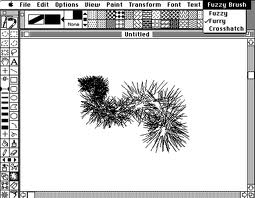
Superpaint "the first complete digital paint system".
Pixellation seems more easy to identify than in the precedent decade. The basic graphics on computer printers keeps on and makes better, but new interfaces is proposed en 1975: the Xerox SuperPaint, "the first complete digital paint system". It is used notably by David Em . at the Xerox Palo Alto Research Center (Xerox PARC). 1976, he makes an articulated 3D digital insect at Information International, Inc. (III) that could walk, jump, and fly, the first 3D character created by a fine artist.[2].
Summary about computer graphics by [Masson]: "Pioneering work was done by Jim Blinn, David Em... to create some of the early serious computer art in raster form".
In 1975 also the researcher Steve Sassson, at Kodak, presents the first digital photography. Wade Shaw makes photograph (we don't know with which camera).
As for the graphic generation and printing, well explored in the precedent decade, new artists are listed (notably through the Recode project and the Victoria and Albert Museum (London) collections. They can use not only the printers of large computers, but the outputs of microcomputers, which have matrix (needles) printers : Apple II (1977) and minimal graphic software.
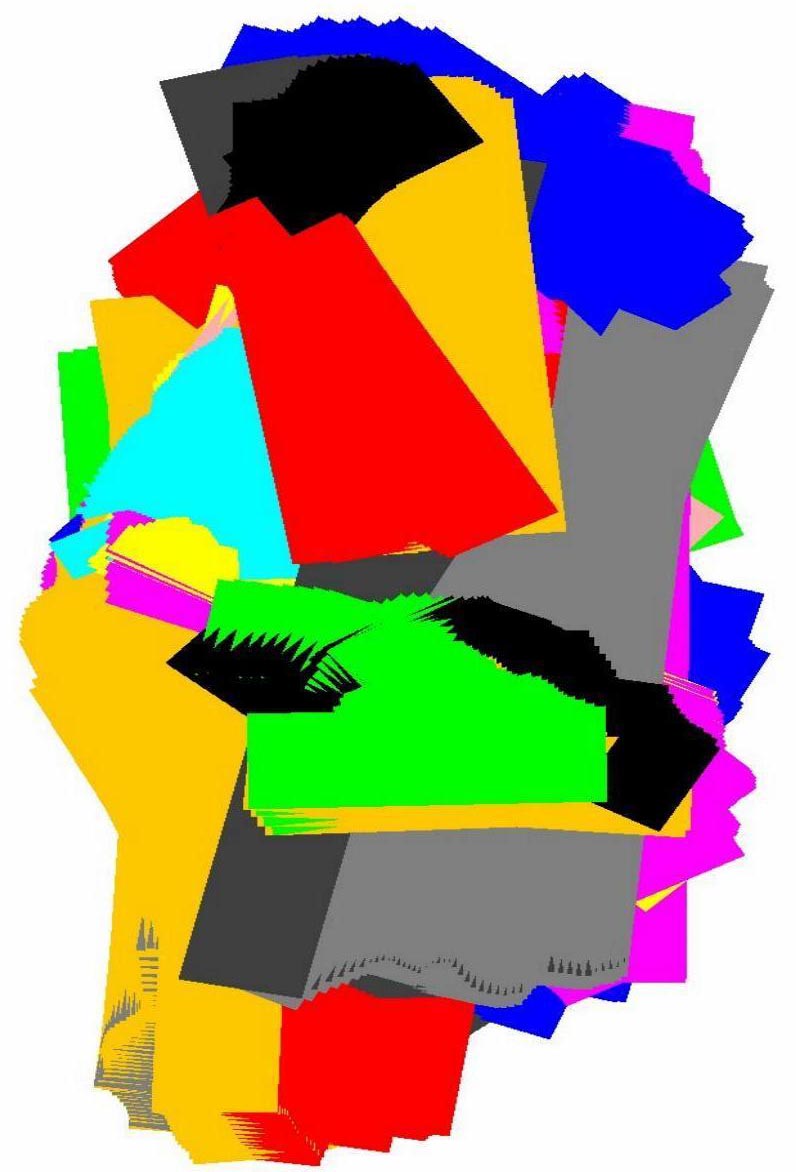
Christian de Cambiaire
We can quote : : Giorgini Also, Klaus Basset, Jean-H Bevis, Christian De-Cambiaire, Manuek Felguerez , Charles Fritchie, Sture Johanesson, Hiroshi Kawano, Hans-Peter Reuter, Mayer Sasson, James Ver Hague, Georg Vilder. Abe Yoshiyuki is active in 2013. In 1771, Manfred Mohr exhibition is held at ARC, Muséee d'art moderne de la Ville de Paris (Many of his works will be shown in Art Basel 2013).
Bernard Demiaux does his first computer graphics on an Apple II. In the future, he will specialize in interaction.
Around the basic graphics, various experiments are conducted: fractals by Carlos Ginsburg (considered "conceptual), relations with radio waves ( David Hall ), use of stencils (Jacques Palumbo on a printer driven by an IBM computer); image transformations ( Leslie Mezei according to Atari archive), visual effects starting from text ( Robert Bowen ), scientific image processing ( Jean-François Colonna at French Polytechnique school). Colette and Charles Bangart works in couple, or with cooperation "Colette paints pictures every day. Jeff writes algorithms".
More and more elaborate and detailed lines and algorithms are developed by the Algorists, a term coined by Jean-Pierre Hébert who founds an informal group of artists under this name.
Several painters, yet well-established on the tradition world of art, drop their brushes and dedicate themselves to computer art, notably Marc Adrian. (in 1970), Ruth Leavitt and Harold Cohen who starts a long research with different peripherals (for example tortoises) but mainly on software and the affordances of programming, for instance about colors.
Artist begin to cooperate and industry joins the band: the first Siggraph takes place in 1974, uniting scientists, industrial corporations and (some) artists.
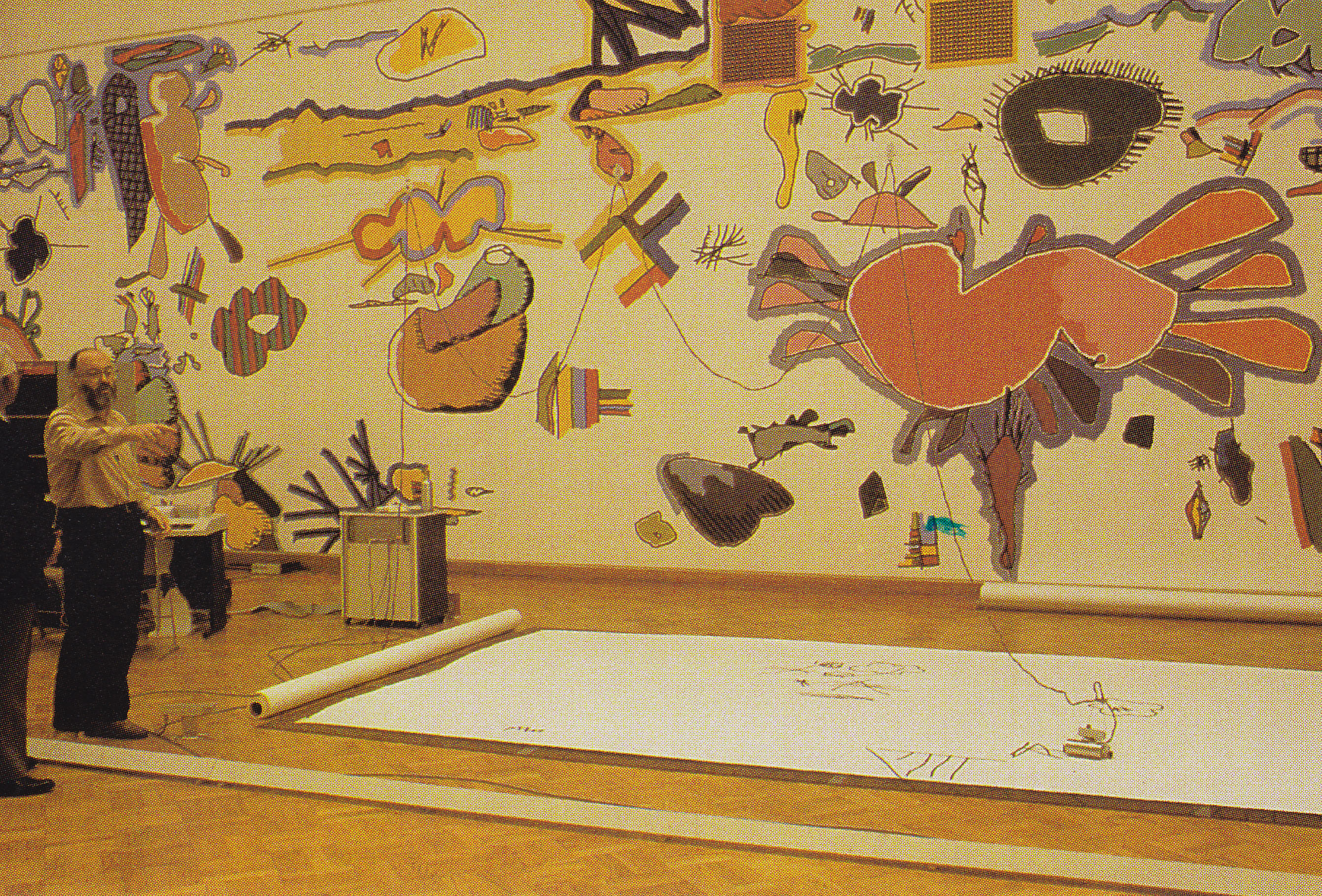
Printing with tortoises by Harold Cohen
Note. Microfilm, which will have a rather short life, due to the progress of electronic technology, opens new ways. There exists, for instance, a microfiche of Vasarely works.
Let's cite also, for painting Hodgkin Carter USA and Horwith Channa USA
For photography; St_Arnaud Raymond USA
Cinema and animation
The first computer generated films dates from the precedent decade (Zajac). In the 1970's, we see multiple developments, on the borders of cinema, animation and video:
Gabor Body Animation, video
Dirk de Bruyn. Optical sound
Larry Cuba. A pioneer in abstract animation. See [Masson].
Ed Emshwiller Cinema animation with digital techniques
Peter Foldes Animation Artistic effects of extrapolation
Glen Keane Disney. Bernard and Bianca.
Chris Knowles. Cinema, combination of sound and image.
Kenneth Knowlton Animation Pixellation, with Lilian Schwartz
Nelson Max. Clay animation, shown at Siggraph;
Pierre Rovère Animation
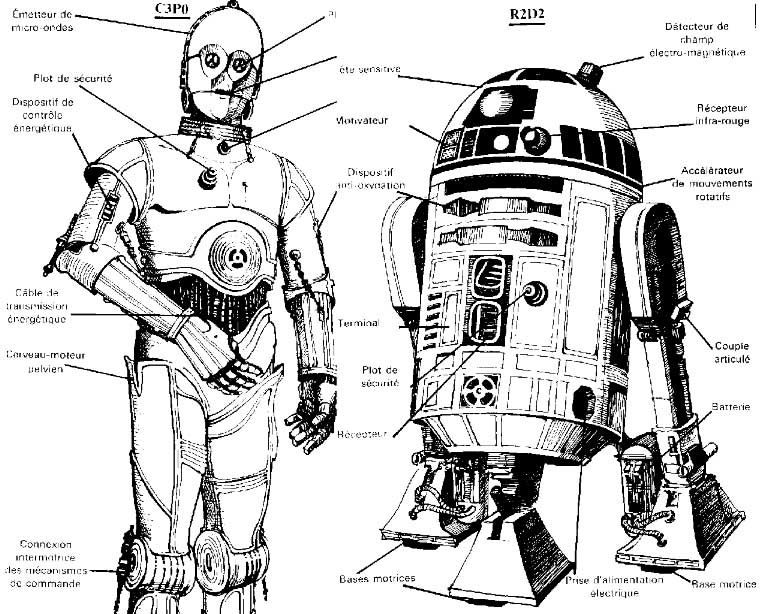
Stephen Spielberg: Starwars
Lilian Schwartz. Pixellation.
Alan Sutcliffe creates a computer simulator showing a 3D terrain flyover, with rendering of computer-generated mountains. [Masson].
Steina Vasulka Animated images, video
Edward Zajec Animation geometrical, The Cube Theme and Variation.
Jose-Maria Cruxent Animation
And, about robots, but not technically digital, we can't omit the first episode of Star Wars, by George Lucas, in 1977, and the works of Stephen Spielberg.
Also: Layzer Arthur USA
and (Video) Sweeney Skip USA and Abe Shuya Japan
Sculpture and objects, architecture
We are not yet in the full digital. =
For Roman Signer the works are not digital by themselves, but done according to strictly programmed protocols. The research on color/light relations by
Horatio Garcia-Rossi a member of Grav, seems mainly conceptual and analog. We can think the same about the laser lighting of monuments by Dani Karavan.
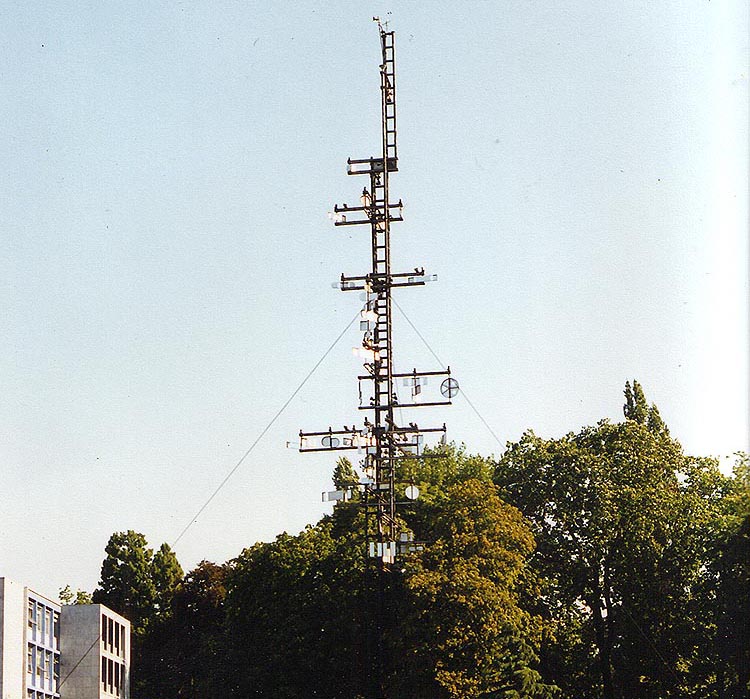
Nicolas Schoeffr. Cybernetic tower.
Some artists engage in new domains. Charlotte Johanesson makes fabrics, James Seawright robotics. Kinetic art is practiced by Joël Stein and on a large scale by Nicolas Schoeffer well known notably for his tower in Liege (Belgium), alas today destroyed.
In architecture, we don't know of meaningful projects in this time.
Nothing important noted about light art.
Multimedia, performance, robots, netwoks, interaction, bio-art...
Technical combination of "media" grows, due to the affordances of electronics and computers. From the simple to the complex, let's quote:
Lowell Cross invents the laser light show.
The Art-Zoïd begins as a music group, then goes multimedia, combining sound and images.
Tina Keane. Mix of video and performance.
Mark Pauline puts robots and machines on stage, with gigantic and violent shows as BattleBots and Robot Wars.
The Ludicart group add technology to theater performance.
Kit Galloway and Sherrie Rabinowitz, with Satellite arts (1977) bridge the categories: dance, telecommunications, web.
X Robert-Adrian, coming from radio, makes art on any kind of network.
Fred Forest begins to practice his "sociological art", media oriented.
Also: Rosen Avi Israel
The spectactors engagement, keeping on the post-modern orientation of the sixties, makes use of various technologies.
Augusto Boal's Teatro do oprimido, is not so digital technically but includes reflections on it (read his discourse, full text, in [Wardrip-Fruin, 2003] (paper only, and expensive).
- In 1969, the stage director Guy Kayat presents near Paris an adaptation of 0edipus the king, by Sophocles. After the interpretation of the three first acts, the actors speak with the spectators and offer them several options: scenic layouts, music, situations, etc. The choices are sent to an IBM computer (HEC computing center) which sends back the state setting to end the play ( (0.1. Informatique, May 12, 1969). Nota pour the historians: we keep in our archives the documents of the time: press kit and a listing of the dialogue wih the computer.
- In 1970, the writer Georges Perec presents an "algorithmic play", The augmentation, at the Gaité Montparasse theater in Paris, with a stage setting by Marcel Cuvelier and six actors, who are by turns a computer instrucdion, a conditional jump or a processed data (O.1. Informatique, March 16, 1970).
In 1977 the happening-performance Sendreceive offered several hours of interactive satellite transmission with Lisa Bear, Willoughby Sharp; Sharon Grace and Carl Loeffler.
Piotr Kowalski showed an "installation in which the spectator takes part in real time on visual and sound records of his moves, and he can reverse the time evolution".
And some kind of bio-art opens a way which is still today (2013) little explored, by Stelarc, adding technical devices to his own body and, on the opposite, on the artificial life experiments of Thomas Ray.
DICCAN'S PARTNERS:
Paris ACM Siggraph, the French chapter of ACM Siggraph, worldwide non-profit organization of computer graphics.
